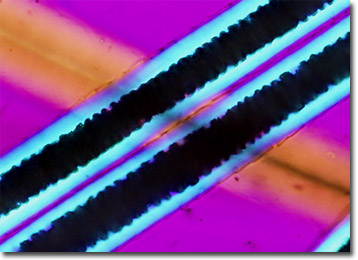Polarized Light Microscopy Digital Image Gallery
Leopard Hair
Members of the family Felidae, leopards are large, solitary cats well known for the distinctive spotting of their fur, which is commonly buff, yellow, or gray. Leopards that have black fur also occur and are generally known as black panthers.

View a second image of Leopard Hair
Several different races of leopards have been classified based on their coloration, markings, and size. There is, however, only one true species of the animals, which is scientifically described as Panthera pardus. Despite their common names, the snow leopard, clouded leopard, and leopard cat are distinct genera, the true leopard being more closely related to the lion and the tiger, which are both members of the genus Panthera. Though somewhat smaller than lions and tigers, leopards are highly skilled hunters that may take down sizable prey, such as antelopes, although they more often consume smaller animals, including birds, dogs, monkeys, and rodents. They are also good swimmers and climbers that frequently store extra meat in the branches of trees.
Inhabitants of parts of Africa and Asia, leopards have become threatened or endangered in most of their range. The dire situation of these beautiful animals stems in large part from human exploitation. The bones of the animals are, for instance, often sought after for use in traditional Asian medicines, and their fur is highly valued in the fashion industry. Leopard fur was in particularly high demand in the 1960s, when Jacqueline Kennedy’s leopard coat designed by Oleg Cassini spawned a fashion craze. The tremendous number of spotted animal skins that were sold in the world market as a result of an item he fabricated, however, led Cassini to develop a line of faux fur in an attempt to provide a more humane and inexpensive alternative. Over the subsequent years, many restrictions have been placed on the sale and purchase of leopard skins in many countries, and faux varieties have become increasingly popular. Nevertheless, demand for the genuine article stubbornly persists.
